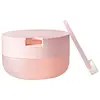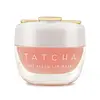What's inside
What's inside
 Key Ingredients
Key Ingredients

 Benefits
Benefits

 Concerns
Concerns

 Ingredients Side-by-side
Ingredients Side-by-side

Hydrogenated Poly(C6-14 Olefin)
EmollientHydrogenated Polyisobutene
EmollientEthylene/Propylene/Styrene Copolymer
Caprylic/Capric Triglyceride
MaskingTocopheryl Acetate
AntioxidantSqualane
EmollientWater
Skin ConditioningStearyl Alcohol
EmollientLithospermum Erythrorhizon Root Extract
Skin ConditioningCetyl Alcohol
EmollientParfum
MaskingButylene/Ethylene/Styrene Copolymer
Myristyl Alcohol
EmollientHydrogenated Olive Oil Cetyl Esters
Emulsion StabilisingOryza Sativa Bran Wax
Skin ConditioningHydrogenated Lecithin
EmulsifyingButylene Glycol
HumectantCitronellol
PerfumingPentaerythrityl Tetra-Di-T-Butyl Hydroxyhydrocinnamate
AntioxidantMenthoxypropanediol
MaskingLinalool
PerfumingCeramide AP
Skin Conditioning1,2-Hexanediol
Skin ConditioningGeraniol
PerfumingLimonene
PerfumingCholesterol
EmollientCI 77492
Cosmetic ColorantHexyl Cinnamal
PerfumingCeramide NP
Skin ConditioningPropanediol
SolventPalmitic Acid
EmollientStearic Acid
CleansingGlycine Max Polypeptide
Skin ConditioningSodium Hyaluronate
HumectantEthylhexylglycerin
Skin ConditioningDisodium EDTA
Hydrolyzed Collagen
EmollientHydrolyzed Hyaluronic Acid
HumectantSodium Hyaluronate Crosspolymer
HumectantHyaluronic Acid
HumectantPaeonia Albiflora Root Extract
Skin ConditioningSodium Acetylated Hyaluronate
HumectantPaeonia Albiflora Flower Extract
TonicHydrogenated Poly(C6-14 Olefin), Hydrogenated Polyisobutene, Ethylene/Propylene/Styrene Copolymer, Caprylic/Capric Triglyceride, Tocopheryl Acetate, Squalane, Water, Stearyl Alcohol, Lithospermum Erythrorhizon Root Extract, Cetyl Alcohol, Parfum, Butylene/Ethylene/Styrene Copolymer, Myristyl Alcohol, Hydrogenated Olive Oil Cetyl Esters, Oryza Sativa Bran Wax, Hydrogenated Lecithin, Butylene Glycol, Citronellol, Pentaerythrityl Tetra-Di-T-Butyl Hydroxyhydrocinnamate, Menthoxypropanediol, Linalool, Ceramide AP, 1,2-Hexanediol, Geraniol, Limonene, Cholesterol, CI 77492, Hexyl Cinnamal, Ceramide NP, Propanediol, Palmitic Acid, Stearic Acid, Glycine Max Polypeptide, Sodium Hyaluronate, Ethylhexylglycerin, Disodium EDTA, Hydrolyzed Collagen, Hydrolyzed Hyaluronic Acid, Sodium Hyaluronate Crosspolymer, Hyaluronic Acid, Paeonia Albiflora Root Extract, Sodium Acetylated Hyaluronate, Paeonia Albiflora Flower Extract
Triisostearin
Skin ConditioningPolyglyceryl-2 Triisostearate
EmulsifyingSqualane
EmollientDextrin Palmitate
EmulsifyingVp/Hexadecene Copolymer
Silica
AbrasiveDextrin Palmitate/Ethylhexanoate
EmulsifyingCamellia Japonica Seed Oil
EmollientPrunus Persica Kernel Extract
MoisturisingPrunus Persica Juice
MoisturisingPrunus Persica Leaf Extract
EmollientCitrus Unshiu Peel Extract
MaskingSaccharomyces/Rice Ferment Filtrate
Skin ConditioningCamellia Sinensis Leaf Extract
AntimicrobialCladosiphon Okamuranus Extract
Skin ConditioningAllantoin
Skin ConditioningStearyl Glycyrrhetinate
Skin ConditioningTocopherol
AntioxidantPyridoxine Hcl
Skin ConditioningWater
Skin ConditioningPropanediol
SolventButylene Glycol
HumectantEthylhexylglycerin
Skin ConditioningParfum
MaskingPhenoxyethanol
PreservativeLimonene
PerfumingLinalool
PerfumingCI 77491
Cosmetic ColorantTriisostearin, Polyglyceryl-2 Triisostearate, Squalane, Dextrin Palmitate, Vp/Hexadecene Copolymer, Silica, Dextrin Palmitate/Ethylhexanoate, Camellia Japonica Seed Oil, Prunus Persica Kernel Extract, Prunus Persica Juice, Prunus Persica Leaf Extract, Citrus Unshiu Peel Extract, Saccharomyces/Rice Ferment Filtrate, Camellia Sinensis Leaf Extract, Cladosiphon Okamuranus Extract, Allantoin, Stearyl Glycyrrhetinate, Tocopherol, Pyridoxine Hcl, Water, Propanediol, Butylene Glycol, Ethylhexylglycerin, Parfum, Phenoxyethanol, Limonene, Linalool, CI 77491
 Reviews
Reviews

Ingredients Explained
These ingredients are found in both products.
Ingredients higher up in an ingredient list are typically present in a larger amount.
Butylene Glycol (or BG) is used within cosmetic products for a few different reasons:
Overall, Butylene Glycol is a safe and well-rounded ingredient that works well with other ingredients.
Though this ingredient works well with most skin types, some people with sensitive skin may experience a reaction such as allergic rashes, closed comedones, or itchiness.
Learn more about Butylene GlycolEthylhexylglycerin (we can't pronounce this either) is commonly used as a preservative and skin softener. It is derived from glyceryl.
You might see Ethylhexylglycerin often paired with other preservatives such as phenoxyethanol. Ethylhexylglycerin has been found to increase the effectiveness of these other preservatives.
Limonene is a fragrance that adds scent and taste to a formulation.
It's found in the peel oil of citrus fruits and other plants such as lavender and eucalyptus. The scent of limonene is generally described as "sweet citrus".
Limonene acts as an antioxidant, meaning it helps neutralize free radicals.
When exposed to air, oxidized limonene may sensitize the skin. Because of this, limonene is often avoided by people with sensitive skin.
The term 'fragrance' is not regulated in many countries. In many cases, it is up to the brand to define this term. For instance, many brands choose to label themselves as "fragrance-free" because they are not using synthetic fragrances. However, their products may still contain ingredients such as essential oils that are considered a fragrance.
Learn more about LimoneneLinalool is a fragrance and helps add scent to products. It's derived from common plants such as cinnamon, mint, citrus, and lavender.
Like Limonene, this ingredient oxidizes when exposed to air. Oxidized linalool can cause allergies and skin sensitivity.
This ingredient has a scent that is floral, spicy tropical, and citrus-like.
Learn more about LinaloolParfum is a catch-all term for an ingredient or more that is used to give a scent to products.
Also called "fragrance", this ingredient can be a blend of hundreds of chemicals or plant oils. This means every product with "fragrance" or "parfum" in the ingredients list is a different mixture.
For instance, Habanolide is a proprietary trade name for a specific aroma chemical. When used as a fragrance ingredient in cosmetics, most aroma chemicals fall under the broad labeling category of “FRAGRANCE” or “PARFUM” according to EU and US regulations.
The term 'parfum' or 'fragrance' is not regulated in many countries. In many cases, it is up to the brand to define this term.
For instance, many brands choose to label themselves as "fragrance-free" because they are not using synthetic fragrances. However, their products may still contain ingredients such as essential oils that are considered a fragrance by INCI standards.
One example is Calendula flower extract. Calendula is an essential oil that still imparts a scent or 'fragrance'.
Depending on the blend, the ingredients in the mixture can cause allergies and sensitivities on the skin. Some ingredients that are known EU allergens include linalool and citronellol.
Parfum can also be used to mask or cover an unpleasant scent.
The bottom line is: not all fragrances/parfum/ingredients are created equally. If you are worried about fragrances, we recommend taking a closer look at an ingredient. And of course, we always recommend speaking with a professional.
Learn more about ParfumPropanediol is an all-star ingredient. It softens, hydrates, and smooths the skin.
It’s often used to:
Propanediol is not likely to cause sensitivity and considered safe to use. It is derived from corn or petroleum with a clear color and no scent.
Learn more about PropanediolSqualane is an emollient that helps the skin hold onto moisture. It's an oily liquid that occurs naturally in certain types of fish and plant oils.
Because squalane boosts hydration in the skin, it also comes with plenty of benefits: it is an antioxidant and can help fight free radicals and skin damage. Squalane is also found to have a detoxifying effect when applied.
Squalane comes from squalene, which occurs naturally within the sebum of our skin. It is one of the oils our skin produces to keep itself hydrated. Squalane is the hydrogenated version of squalene and has a longer shelf life.
Research shows that squalane is non-irritating (even at 100% concentration).
In general, it's a fantastic ingredient. It does a great job at hydrating the skin, and it's suitable for those with sensitive skin.
The source of squalane may impact malassezia / fungal acne. This is because olive oil derived squalane can contain impurities such as fatty acids and plant waxes. Sugarcane derived squalane is recommended for anyone with malassezia concerns.
Is squalane vegan?
This depends on the source. Squalane can be derived from both plants and animals. Most squalane used in skincare comes from plants.
Please note: the source of squalane is only known if disclosed by the brand. We recommend reaching out to the brand if you have any questions about their squalane.
Read more about squalene with an "e".
Is squalane an oil?
Squalane is often called an oil, but it’s technically not; it’s a hydrocarbon, meaning it’s only made of carbon and hydrogen, unlike true oils which are triglycerides made of fatty acids and glycerol.
The term “oil-free” isn’t regulated, so companies can define it however they want. Some exclude all oils, while others just avoid mineral oil or comedogenic oils.
While some people avoid oils thinking they cause breakouts, the right kind of oil (or oil-like ingredient like squalane) can actually help balance and hydrate your skin. It’s worth testing out simple oils or squalane to see what works best for your skin.
Learn more about SqualaneWater. It's the most common cosmetic ingredient of all. You'll usually see it at the top of ingredient lists, meaning that it makes up the largest part of the product.
So why is it so popular? Water most often acts as a solvent - this means that it helps dissolve other ingredients into the formulation.
You'll also recognize water as that liquid we all need to stay alive. If you see this, drink a glass of water. Stay hydrated!
Learn more about Water